Julius von Klever, known in Russia as Yuli Yulevich Klever (Юлий Юльевич Клевер), stands as a significant figure in late 19th and early 20th-century Russian art. A landscape painter of German-Baltic origin, he achieved remarkable popularity during his lifetime, captivating audiences with his atmospheric and often romanticized depictions of the Russian wilderness, particularly its snow-laden forests and dramatic sunsets. Though sometimes viewed critically for his commercial success and perceived academicism, Klever's ability to evoke mood and capture the ephemeral beauty of nature secured him a lasting place in the history of Russian landscape painting.
Early Life and Artistic Awakening
Julius Klever was born on January 19, 1850, in Dorpat (now Tartu), Estonia, then part of the Russian Empire. His background was academic; his father, Dr. Julius Klever, was a professor of chemistry at the local Veterinary Institute. His mother, Wilhelmine Elisabeth (née von Zeitler), was of German descent. This German-Baltic heritage would subtly inform his artistic sensibilities throughout his career.
From a young age, Klever displayed a clear inclination towards drawing and painting. Recognizing his son's talent, his father supported his artistic pursuits. He received his initial formal art instruction while attending the Dorpat Gymnasium (grammar school). A key figure in his early development was the German-Baltic artist Konstantin von Kügelgen (or possibly Carl von Kügelgen, sources sometimes vary on the first name but refer to the same influential family of artists active in the region). Kügelgen, himself a respected landscape painter, provided guidance and encouragement, nurturing the boy's burgeoning skills and likely instilling in him a love for depicting the local scenery.
This early exposure to art, coupled with the natural beauty of the Estonian landscape, laid the foundation for Klever's future specialization. His innate talent was evident, suggesting a path different from the academic career his family might have initially envisioned.
Academic Pursuits and an Independent Path
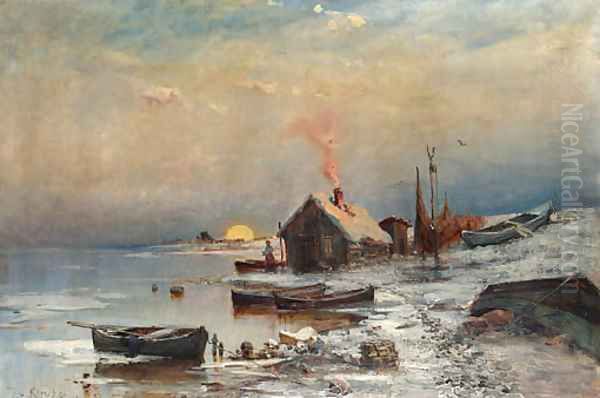
Following his secondary education, Klever moved to the imperial capital, St. Petersburg, in 1867. Bowing perhaps to familial expectations or conventional aspirations, he enrolled in the architecture department of the prestigious Imperial Academy of Arts. Architecture, however, proved not to be his true calling. The structured, technical demands of the discipline did not align with his passion for capturing the organic forms and atmospheric moods of nature.
After approximately one year of architectural studies (until 1868), Klever made a decisive shift. He transferred to the Academy's landscape painting class. Here, he studied under notable professors such as Sokrat Vorobiev, a respected painter known for his classical landscapes, and Mikhail Clodt, a member of the famous Clodt von Jürgensburg artistic family and a proponent of detailed realism in landscape.
Despite studying under these established figures, Klever developed a reputation for being somewhat independent, even rebellious, within the Academy's structured environment. He was more interested in pursuing his own artistic vision than strictly adhering to academic formulas. This independent streak led him to leave the Academy before formally completing the full course of study. He did not receive a graduation diploma, choosing instead to forge his own path based on his rapidly developing skills and unique style.
A Meteoric Rise to Prominence
Klever's decision to leave the Academy without graduating did not hinder his career; in fact, his rise was remarkably swift. He began exhibiting his works independently, and they quickly attracted attention for their technical skill and evocative power. His landscapes, often depicting dramatic sunsets, deep forests, or snow-covered expanses, resonated with the public and, crucially, with influential patrons.
A pivotal moment occurred early in his career, possibly around 1873 or 1874, when one of his paintings, often cited as "Sunset," was acquired by Tsar Alexander II himself. This imperial endorsement significantly boosted Klever's reputation and desirability. Further patronage came from other members of the Romanov family, including Grand Duke Alexei Alexandrovich, and prominent collectors like Pavel Tretyakov, the founder of the renowned Tretyakov Gallery in Moscow.
His success was not limited to patronage. In 1878, despite his lack of a formal diploma, the Academy of Arts recognized his achievements and awarded him the title of Academician. Just a few years later, in 1881, he was appointed as a Professor at the Academy, a testament to his standing in the St. Petersburg art world. He became known for his engaging teaching style and attracted numerous students.
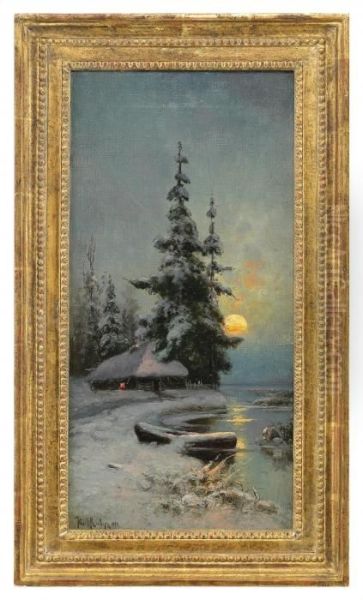
During this period, he also collaborated with figures outside the immediate art world. For instance, in 1879, he reportedly worked alongside the famous actor Vasily Samoylov while painting on Nargen Island (now Naissaar) off the coast of Estonia, demonstrating his integration into the broader cultural milieu of the capital. Klever had become one of the most fashionable and commercially successful painters in Russia.
Artistic Style and Themes
Klever's art occupies a unique space within Russian landscape painting, distinct from the dominant movements of his time. His style is often characterized as a blend of late Romanticism and a form of atmospheric Realism, sometimes described as Lyrical Romanticism.
#### The Romantic and the Real
Influenced perhaps by his German-Baltic roots and exposure to German Romantic painters (like Caspar David Friedrich or artists of the Düsseldorf school, though direct links are debated), Klever imbued his landscapes with a strong sense of emotion and mood. He was less concerned with the precise, almost scientific rendering of nature favored by some realists, and more interested in capturing its poetic essence, its grandeur, and its often melancholic beauty.
However, his work was also grounded in careful observation. His depictions of trees, snow, water, and light effects demonstrate considerable technical skill and attention to detail. This combination allowed him to create scenes that felt both believable and emotionally charged, appealing to a wide audience seeking beauty and escapism in art.
#### Capturing the Russian Soul
Klever became particularly famous for his depictions of specific aspects of the Russian landscape. He excelled at painting deep, often impenetrable forests, marshy terrains, and, above all, winter scenes. His snowscapes are perhaps his most iconic works, capturing the stillness, the crisp air, the low light, and the subtle color variations of the Russian winter with remarkable sensitivity.
Sunsets were another favorite motif. Klever masterfully rendered the dramatic play of light and color as the sun dipped below the horizon, often silhouetting skeletal trees against fiery skies. These scenes frequently carry a sense of solitude, mystery, or sublime beauty, tapping into Romantic notions of nature's power and indifference. While often idealized, his landscapes aimed to convey a feeling perceived as quintessentially Russian – vast, untamed, and beautiful in its austerity.
#### The Language of Light and Atmosphere
Technique was central to Klever's success. He possessed a remarkable ability to render different textures – the fluffiness of snow, the rough bark of trees, the reflective surface of ice or water. His brushwork could be detailed yet retain a sense of painterly freedom.
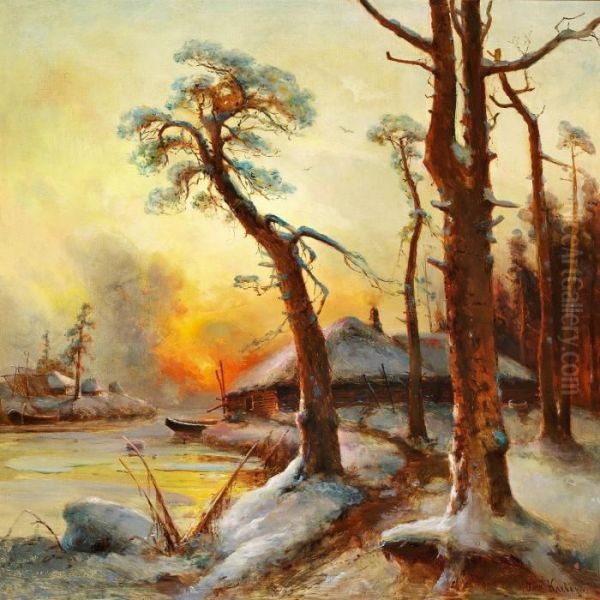
His use of color and light was particularly distinctive. He often employed a rich, sometimes dramatic palette, especially in his sunsets, contrasting deep shadows with brilliant highlights. In his winter scenes, he explored the subtle blues, pinks, and violets found in snow and winter light. Atmosphere was paramount; whether depicting a misty morning, a still winter evening, or the moments before a storm, Klever focused on creating a palpable sense of mood and place. This focus on transient effects and emotional resonance set him apart.
#### A Counterpoint to the Wanderers
Klever's career coincided with the flourishing of the Peredvizhniki (the "Wanderers" or "Itinerants"), a group of realist painters who dominated Russian art in the latter half of the 19th century. Artists like Ivan Shishkin, known for his detailed forest epics, Alexei Savrasov, famous for his lyrical "mood landscapes" like "The Rooks Have Arrived," and Isaac Levitan, the master of evocative Russian scenery, focused on depicting the reality of Russian life and landscape, often with social undertones.
Klever, while contemporary, operated largely outside this circle. He did exhibit alongside them occasionally but was generally seen as representing a different, more 'salon' or academic approach. His work was often criticized by proponents of the Wanderers for being overly picturesque, theatrical, or lacking in social relevance. Klever prioritized aesthetic effect and emotional impact, sometimes repeating successful motifs to meet market demand, which led to accusations of commercialism. He competed with the Wanderers for public attention and patronage, representing a more conservative, though highly popular, strand of landscape painting. His focus on light and atmosphere, however, also finds parallels in the work of contemporaries like Arkhip Kuindzhi, another independent artist celebrated for his dramatic light effects. He can also be seen in the broader context of Russian landscape tradition that includes the seascape master Ivan Aivazovsky and the tragically short-lived talent Fyodor Vasilyev.
Signature Works
Throughout his long career, Klever produced a vast number of paintings. While certain themes and compositions recur, several works stand out as representative of his style and contribution:
"Winter Sunset in the Spruce Forest" (various versions, e.g., 1890s): This archetypal Klever theme combines several of his strengths – the dense, snow-laden spruce forest, the dramatic lighting of a winter sunset casting long blue shadows and warm highlights, and a palpable sense of stillness and cold. These works perfectly encapsulate his romantic vision of the Russian winter.
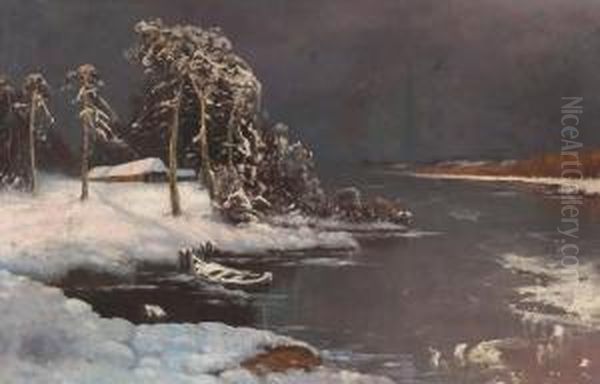
"Forest King" (or "King of the Forest," 1887): Often depicting a mighty, ancient tree (typically an oak or pine) standing sentinel in the forest, this subject highlights Klever's interest in the power and majesty of nature. The central tree becomes a symbol of endurance and the untamed wilderness.
"A Hut in Winter" (or "Winter Hut," 1889): These scenes often show a small, isolated wooden dwelling half-buried in snow, smoke curling from the chimney. They evoke feelings of solitude, shelter against the elements, and the human presence within the vastness of the winter landscape. The mood can range from cozy to desolate.
"Thaw" (various versions): Contrasting with his crisp winter scenes, Klever also depicted the transition to spring, with melting snow, patches of dark earth emerging, and swollen streams. These works capture a different mood, one of anticipation and renewal.
"Red Riding Hood in the Forest" (c. 1887-1890s): Klever occasionally incorporated narrative or fairy-tale elements. This popular subject placed the familiar figure within one of his characteristic deep, atmospheric forests, blending genre with landscape and adding a layer of enchantment or subtle menace.
"Island of Nargen" (various views, late 1870s onwards): Reflecting his connection to his Estonian roots, Klever painted numerous views of this island near Tallinn. These works often feature coastal scenes, rocky shores, and pine forests under different light conditions, showcasing his versatility beyond the typical Russian forest interiors.
These examples illustrate Klever's recurring motifs and his mastery in creating atmospheric, visually appealing landscapes that resonated deeply with his contemporary audience.
The Mature Artist and International Recognition
By the late 19th century, Klever was at the height of his fame and productivity. As a professor at the Academy of Arts, he influenced a generation of students. His studio was highly productive, sometimes employing assistants to help meet the enormous demand for his work, a practice not uncommon at the time but one that occasionally drew criticism regarding authenticity and repetition.
His reputation extended beyond Russia's borders. He participated in international exhibitions, including the prestigious Paris Salon, as well as major shows in Berlin, Munich, and Vienna. His works were acquired by international collectors, solidifying his status as one of Russia's most recognized artists abroad during that era. He received various awards and honors both domestically and internationally.
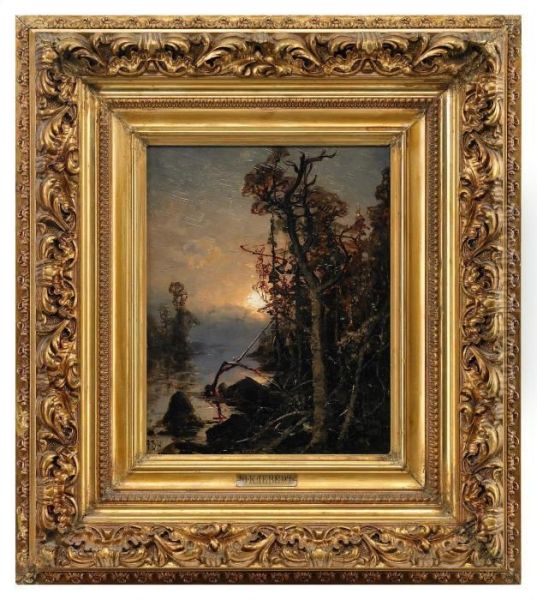
His style remained relatively consistent, focusing on the landscape themes that had brought him success. While perhaps not breaking new ground in the manner of the avant-garde movements emerging at the turn of the century, he continued to refine his technique and produce works of high quality that satisfied the tastes of his patrons and the public.
Challenges and Later Years
Despite his immense success, Klever's later career was not without difficulties. Around the turn of the century, he became embroiled in a scandal. As the organizer of an art exhibition receiving state funds, he faced accusations of financial impropriety or misuse of funds. The details remain somewhat obscure, but the controversy significantly impacted his standing and led to his departure from his professorship at the Academy.
Seeking to distance himself from the scandal, Klever left Russia around 1908 and spent several years living in Germany, primarily in Neustrelitz and Berlin. He continued to paint and exhibit during this period abroad.
He returned to Russia around 1915, shortly before the tumultuous events of the Revolution. The societal upheaval dramatically changed the art world and the system of patronage he had known. However, Klever adapted to the new reality. After the Bolshevik Revolution, he resumed teaching activities, initially at the Academy of Arts (which underwent several name changes) and later at the Petrograd State Art and Industry Technical School (formerly the Stieglitz School of Technical Drawing). He continued to paint, though perhaps with less prominence than in his imperial heyday.
Julius von Klever died in Leningrad (the new name for St. Petersburg) on December 24, 1924, at the age of 74. He had witnessed the decline of the Russian Empire, the turmoil of revolution, and the beginnings of the Soviet state, all while continuing his artistic practice.
Legacy and Influence
Julius von Klever's legacy is somewhat complex. During his lifetime, he was immensely popular, arguably one of the most commercially successful Russian painters of his generation. His atmospheric landscapes, particularly the winter scenes and sunsets, became iconic representations of the Russian wilderness for many. His works adorned the walls of imperial palaces, noble estates, and bourgeois homes.
However, his very popularity and perceived commercialism led to criticism from proponents of more ideologically driven or avant-garde art movements. He was sometimes dismissed as a 'salon' painter, prioritizing picturesque effects over deeper meaning or formal innovation. His distance from the socially conscious realism of the Peredvizhniki placed him in a different category within Russian art history.
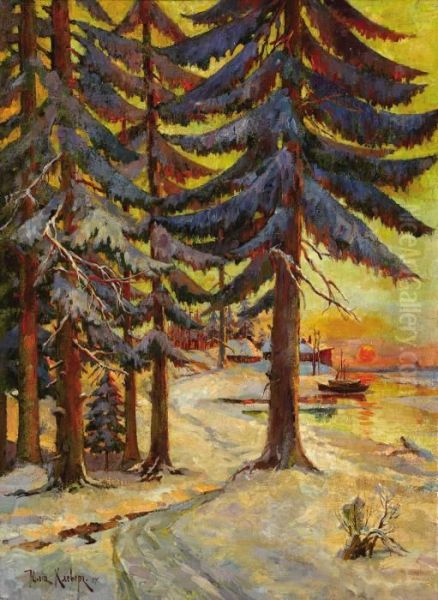
Nevertheless, his technical skill and his undeniable ability to capture mood and atmosphere are widely acknowledged. His paintings continue to be popular with the public and achieve high prices at auction. His works are held in major museum collections, including the State Tretyakov Gallery in Moscow and the State Russian Museum in St. Petersburg, as well as numerous regional museums in Russia and collections abroad.
Klever also established something of an artistic dynasty. Several of his children followed in his footsteps and became artists, including his daughter Maria Klever (married name Komarova), and sons Oscar Klever and Julius Yulevich Klever Jr., who often worked in styles reminiscent of their father's.
Today, Julius von Klever is appreciated for his mastery of landscape technique and his contribution to the romantic strand of Russian art. He remains best known as the painter who captured the dramatic beauty and profound stillness of the Russian winter forest like few others.
Conclusion
Julius von Klever navigated the shifting artistic and political landscapes of late Imperial and early Soviet Russia with remarkable success. From his early recognition in Dorpat to his professorship at the St. Petersburg Academy and international acclaim, he built a career on his exceptional ability to render the moods of the Russian landscape. While his approach differed from the dominant realist movement of the Peredvizhniki, his focus on atmosphere, light, and the romanticized wilderness resonated deeply with his contemporaries. His iconic winter scenes and dramatic sunsets remain powerful evocations of nature's beauty and mystery, securing his place as a distinctive and enduring master of Russian landscape painting.